 Berlin Air-raid
Shelters, Flak Towers and Bunkers
Berlin Air-raid
Shelters, Flak Towers and Bunkers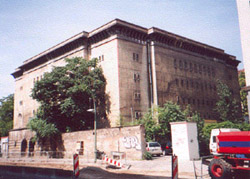
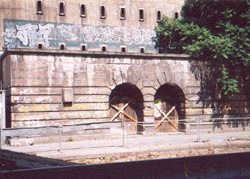
Albrechtstrasse/Reinhardtstrasse air-raid shelter
near Friedrichstrasse Station.
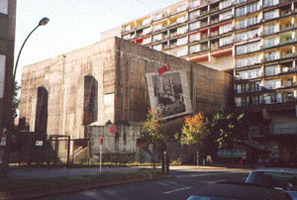
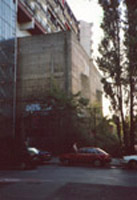
Pallasstrasse air-raid shelter, Schöneberg
The post-war block of flats were built over the shelter as
the cost of demolition would have been prohibitive.
During the Cold War the shelter was in use as a NATO food-store.
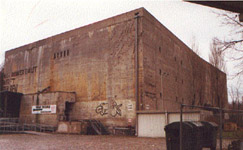
View of the Anhalter Bahnhof air-raid shelter
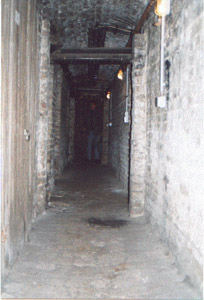
A cellar, typical of those used by civilians during Air-raids.
This one is in Immanuelkirchstrasse, Prenzlauer Berg. They were
often fitted out with wooden benches along the walls.
The end walls walls connecting the cellars on either side would
be marked with whitewash so that in the event of the
building above collapsing, the wall could be knocked through and
the occupants escape to the adjoining cellar.
The Berlin Flak Towers
The three gigantic Flak towers were built in Berlin and were 130 ft high and took only six months to build Each had its accompanying smaller command tower nearby.
The Flaktürme are, even in their present partly demolished and buried state, awesome buildings. They were a strange, but effective concept of modern fortress. Anti-aircraft gun platform, radar tower, observation post, hospital, air raid shelter, museum artefact depository, communication centre and after the war hostels for the homeless and DP's, displaced persons.
They provided excellent observation posts during the last days of the war as the Soviet forces encircled Berlin.
They were garrisoned by 100 Hitler Youth Luftwaffenhlfer commanded by experienced Luftwaffe Officers and NCO's of Flakturm-Abtilung 123.
NB Sometimes the main tower is referred to as the Geschützturm, lit. gun tower or turret.
The Gefechtsturm or G-Turm (lit. "Battle Tower") was a
light and heavy calibre anti-aircraft gun platform with ammunition magazine.
Parts of the tower were designated as shelter for the civilian population
during air raids
The smaller Leitturm or L-Turm (lit. "Lead Tower")
was the Command Centre and housed on the roof retractable radar for direction
finding and ranging linked to the aniti-aircraft guns. It also housed important
communication equipment. Also armed with anti-aircraft guns.
Lower parts of the towers were designated as shelter for the civilian population during air raids and it is said that up to18000 could shelter within.
After the war, under the terms of the surrender, the Flaktowers were required to be destroyed as they were technically an offensive weapon of war. The air raid shelters could remain. All were used for a short time as temporary shelter for the homeless.
Flakturm I - Zoo Tiergarten

Flakturm II- Freidrichshain

The picture above shows the Friedrichshain Flakturm after partial
demolition and in the process of being buried with the debris of bomb damaged
and demolished buildings.
The inset illustration shows the "Trümmerfrauen" lit. "Rubble
Women" clearing the streets and cleaning and sorting bricks for re-use.
The partially demolished Reichs Chancellery is in the background.
During the DDR time a paved and walled walk with viewing area was laid
out on the top.

As it is today. The top of the AA gun platform of Flakturm II
in Volkspark Friedrichshain, Prenzlauer Berg
Flakturm III- Humboldthain
The Gefechtsturm or G-Turm (lit. "Battle Tower")
Built in 1941-2, alongside the S-Bahn line, by Italian and French
workers.
In 1948 - 51 the G-Turm was partially demolished and the two
southerly gun platforms destroyed. 1.6 millon cubic meters of rubble was
heaped up around base to form artificial hill and to enhance the park to
plans by Garden and Building Department Leader Gunther Rieck. The
work was carried out by local jobless people. Most of the rubble was pilled
around the south, east and west sides, access being available. But as the
tower is build in close proximity to the railway, to the north, dumping
and pilling rubble was not done to any great depth. So the northern side
is left partially exposed.
The northern face of the bunker is still visible. In the north of the
park, and now known as "Humboldt-85 höhe" it overlooks
the Hochstrasse and the Gesundbrunnen U-Bahn station.

View of the remains of the G-Tower from the Gesundbrunnen U-Bahn
station

The north face.

The lower gallery held the smaller calibre anti-aircraft guns
and the upper gallery the heavy guns.

View under the gallery showing heavy blast damage/spang marks.
The local authorities have erected stairs, safety railings and seating at the top of the two remaining corners, the flaktowers, making fine viewing points. Rock climbing is carried out on the north face.
The smaller Leitturm or L-Turm (lit. "Lead Tower")
Four stories and about 30m (98 ft) high.
Built in 1941-2, alongside Gustav-Meyer Allee, by Italian and French
workers.

Remains of the L-Tower.
The tower was demolished by the French (it was within their Sector) with explosives and is almost completely covered and only a few small upper walls remain visible.
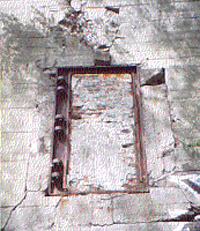
Bricked-up air vent, aprox. 2m high
The bunker was covered and a 20m high, 200m long Rodelbahn (Toboggan Run) constructed.
When Speer's New Reichs Chancellery was completed in 1939 it included a series of underground garages, supply bunkers, personnel shelters.
In 1935-6 the Old Reichs Chancellery on the Willhemstrasse was extended at the rear and a "Diplomat's Hall" was constructed with an air raid shelter underneath, principly for Hilter and his entourage. As the war progressed and with the intensified Allied bombing it was felt that the shelter was not strong enough to withstand the more powerfull bombs being developed. In 1943-4 another bunker was built - this became the Führerbunker. It was situated next to it, slightly deeper and of more massive construction, The earlier Air Raid shelter became known as the Vorbunker or "Front bunker" as it was only possible to enter the Führerbunker by passing through the Vorbunker.Both bunkers were contructed by the Civil Engineers "Hochtief".
After the war the Soviets demolished the surface entrances to the Vor- and Führerbunker. The Reichs Chancellery was finally demolished in 1949, the marble facing having been used to build the Soviet War Memorial in the Tiergarten and the second Memorial in Treptow Park and and the marble was also used to reface the walls of nearby Mohrenstrasse (formerly Wilhelm Platz) U-Bahn station.
Rubble of the Reichs Chancellery was cleared except a mound over the bunker, visible from the West Berlin viewing platforms that overlooked the Potsdammer Platz, which was then in the East German security zone.

When the Berlin Wall was bult in 1961 the bunker mound was in the security
zone on the eastern side of the wall. This area was patrolled by East German
Border Guards and People's Police and remained out of bounds until, in
1988 the East German government started a housing development along the
Wilhelmstrasse. The buried bunker complex would have protruded above the
proposed surface so the 8 ft thick roofs of both bunkers were demolished
and the rubble dropped into the room space below.
All that remains are the buried walls and floors. The apartment blocks
were completed after reunification. The area continues to be redeveloped.

All colour pix © Roy Smith
"The Reichs Chancellery and the Berlin Bunker - Then and Now"
After the Battle magazine.
Special Edition Number 61
The After the Battle mags always have good site reports and photos
"Dunkel Welten"
(Bunker, Tunnel und Gewölbe unter Berlin)
By Dietmar und Igmar Arnold/Frieder Salm
Published by Ch.Links Verlag
German text, superb colour and b&w pictures.
"Bunkerwelten"
Luftschutzanlagen in Nordeutshland
By Michael Foedrowitz
Published by Ch.Links Verlag
German text, superb b&w pictures.
"The Flak Towers in Berlin Hamburg and Vienna 1940-1950"
By Michael Foedrowitz
Published by Shiffer Military History
Good pictures, excellent value.
"The Underground Military Command Bunkers of Zossen, Germany"
By Hans George Kampe
Published by Shiffer Military History
Good pictures, excellent value.
"The Last Days of Hitler"
The Legends - The Evidence - The Truth
By Anton Joachimsthaler - Translated by Helmut Bögler
Published by Arms & Armour Press
Suberb investigation with illustrations.
"Mythos Fürerbunker"
Sven Felix Kellerhoff
Published by Berlin Story, see below.
German text. Good plans and maps.
"The Berlin Bunker"
James P. O'Donnell
Very readable account with much detail.
"The Last Battle"
Cornelius Ryan
Very readable account with much detail.
"The Last Days of Hitler"
Hugh Trevor-Roper
The first book on the subject - the results of H T-R investigation
(on behalf of the British Government) into the fate of Hitler.
If you are in Berlin don't miss the Berlin Story bookshop
Unter den Linden 10
10117 Berlin
GermanyTel/fax 030/20 45 38 42
service@BerlinStory.de
The Berlin Underground Website
http://www.berliner-unterwelten.de/
Superb detailed history and pictures of Humboldhain
Flak tower
http://www.flakturme.com/index.html
Visit Martin Kaule's gigantic site for Bunker information
in Berlin & Brandenburg
http://www.hidden-places.de
Apologies if this page take an age to load because
of the colour pix.
If you know how to make it load quicker, please
let me know!
All colour pix © Roy Smith